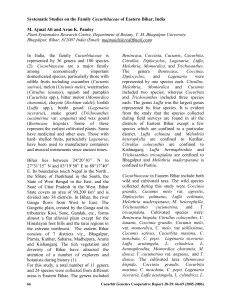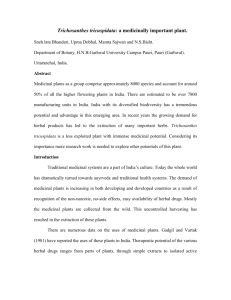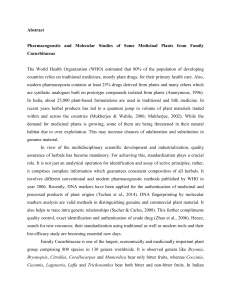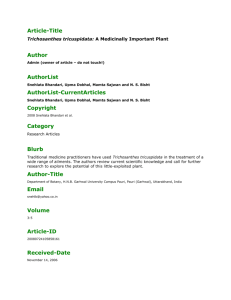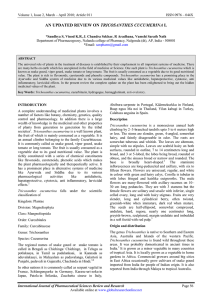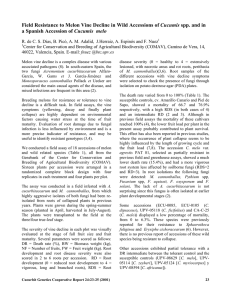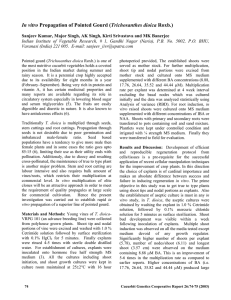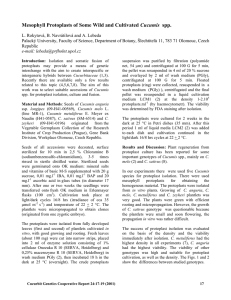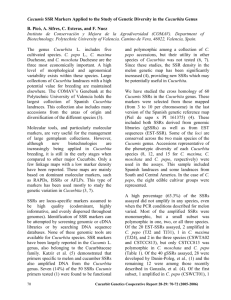Cucurbitaceae M. Ajmal Ali and Arun K. Pandey
advertisement
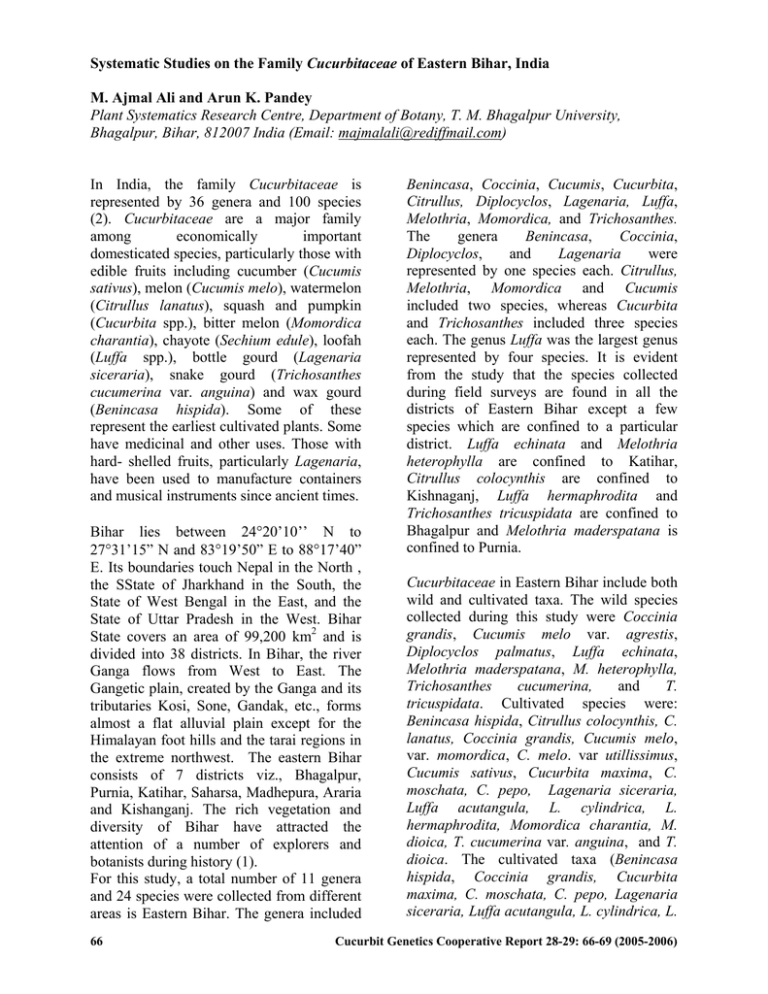
Systematic Studies on the Family Cucurbitaceae of Eastern Bihar, India M. Ajmal Ali and Arun K. Pandey Plant Systematics Research Centre, Department of Botany, T. M. Bhagalpur University, Bhagalpur, Bihar, 812007 India (Email: majmalali@rediffmail.com) In India, the family Cucurbitaceae is represented by 36 genera and 100 species (2). Cucurbitaceae are a major family among economically important domesticated species, particularly those with edible fruits including cucumber (Cucumis sativus), melon (Cucumis melo), watermelon (Citrullus lanatus), squash and pumpkin (Cucurbita spp.), bitter melon (Momordica charantia), chayote (Sechium edule), loofah (Luffa spp.), bottle gourd (Lagenaria siceraria), snake gourd (Trichosanthes cucumerina var. anguina) and wax gourd (Benincasa hispida). Some of these represent the earliest cultivated plants. Some have medicinal and other uses. Those with hard- shelled fruits, particularly Lagenaria, have been used to manufacture containers and musical instruments since ancient times. Bihar lies between 24°20’10’’ N to 27°31’15” N and 83°19’50” E to 88°17’40” E. Its boundaries touch Nepal in the North , the SState of Jharkhand in the South, the State of West Bengal in the East, and the State of Uttar Pradesh in the West. Bihar State covers an area of 99,200 km2 and is divided into 38 districts. In Bihar, the river Ganga flows from West to East. The Gangetic plain, created by the Ganga and its tributaries Kosi, Sone, Gandak, etc., forms almost a flat alluvial plain except for the Himalayan foot hills and the tarai regions in the extreme northwest. The eastern Bihar consists of 7 districts viz., Bhagalpur, Purnia, Katihar, Saharsa, Madhepura, Araria and Kishanganj. The rich vegetation and diversity of Bihar have attracted the attention of a number of explorers and botanists during history (1). For this study, a total number of 11 genera and 24 species were collected from different areas is Eastern Bihar. The genera included 66 Benincasa, Coccinia, Cucumis, Cucurbita, Citrullus, Diplocyclos, Lagenaria, Luffa, Melothria, Momordica, and Trichosanthes. The genera Benincasa, Coccinia, Diplocyclos, and Lagenaria were represented by one species each. Citrullus, Melothria, Momordica and Cucumis included two species, whereas Cucurbita and Trichosanthes included three species each. The genus Luffa was the largest genus represented by four species. It is evident from the study that the species collected during field surveys are found in all the districts of Eastern Bihar except a few species which are confined to a particular district. Luffa echinata and Melothria heterophylla are confined to Katihar, Citrullus colocynthis are confined to Kishnaganj, Luffa hermaphrodita and Trichosanthes tricuspidata are confined to Bhagalpur and Melothria maderspatana is confined to Purnia. Cucurbitaceae in Eastern Bihar include both wild and cultivated taxa. The wild species collected during this study were Coccinia grandis, Cucumis melo var. agrestis, Diplocyclos palmatus, Luffa echinata, Melothria maderspatana, M. heterophylla, Trichosanthes cucumerina, and T. tricuspidata. Cultivated species were: Benincasa hispida, Citrullus colocynthis, C. lanatus, Coccinia grandis, Cucumis melo, var. momordica, C. melo. var utillissimus, Cucumis sativus, Cucurbita maxima, C. moschata, C. pepo, Lagenaria siceraria, Luffa acutangula, L. cylindrica, L. hermaphrodita, Momordica charantia, M. dioica, T. cucumerina var. anguina, and T. dioica. The cultivated taxa (Benincasa hispida, Coccinia grandis, Cucurbita maxima, C. moschata, C. pepo, Lagenaria siceraria, Luffa acutangula, L. cylindrica, L. Cucurbit Genetics Cooperative Report 28-29: 66-69 (2005-2006) hermaphrodita, Momordica charantia, M. dioica, T. cucumerina var. anguina, and T. dioica.) are mainly grown in “diara” regions. Citrullus lanatus, Cucumis melo, var. momordica, C. melo. var utillissimus, C. sativus are cultivated for their edible fruits. Luffa hermaphrodita is cultivated mainly in Bhagalpur district. Cucumis melo var. agrestis, found growing in a wild condition in all the districts of eastern Bihar, is sold in the market as a vegetable crop. Cucurbits are also used in the indigenous system of medicine. Lagenaria siceraria, Trichosanthes dioica, T. cucumerina, T. cucumerina var. anguina, and Benincasa hispida are rich in protein and vitamin C. Each and every part of pointed gourd has high nutritional value. The roots contain amorphous saponin. Species of Momordica are used in diabetes. The seeds of Citrullus lanatus are used as cooling medicine. Root, stem, and leaves of Coccinia grandis are used in indigenous medicine against skin diseases. Fruits of melons are eaten when ripe and are also used in chronic eczema. Bottle gourd (Lagenaria siceraria), ribbed gourd (Luffa acutangula), white gourd (Benincasa hispida), cucumber (Cucumis sativus), and pointed gourd (Trichosanthes dioica) are some of the most common vegetables (3). Plants included in the study are extensive climbers, generally monoecious. The stem varies from slender to robust, sulcate, leaves are cordate to acute or, upper surface of the lamina is 3- lobed, lobes obtuse in Diplocyclos palmatus; 3-7 lobed in Trichosanthes tricuspidata; shortly trilobed or angular or apex acute or shortly acuminate, basal sinus broad, deep in Lagenaria siceraria; 5-lobed in Trichosanthes cucumerina var. anguina; deeply 5-lobed or obscurely 5-angled, apex round in Luffa echinata; 5-7 lobed in Trichosanthes cucumerina var. anguina; terminal lobe acute, others round in Citrullus lanatus; entire to palmately lobed in Coccinia grandis; basal lobes narrow round, 1.5-2.0 cm deep round on both surfaces in Trichosanthes dioica. The tendril bifid in Citrullus lanatus, Cucurbita pepo, Diplocyclos palmatus; 3-fid in Trichosanthes tricuspidata, Luffa acutangula, L. cylindrica; 2-6 fid in Cucurbita maxima; 2-3 fid in T. cucumerina var. anguina, T. cucumerina, many fids in Cucurbita moschata. The shape of tendril varies from slender to filiform. The male flowers fasiculate in Cucumis melo, C. sativus, Melothria maderspatana; solitary in Momordica charantia, M. dioica, Cucurbita moschata; racemose or paniculata; either solitary, robust in Trichosanthes cucumerina var. anguina; few to many - flowered in Melothria heterophylla; 5-12 flowered in Luffa echinata; 15-20 flowered in Luffa cylindrica; 17-20 flowered at the apex in Luffa acutangula. The female flower is solitary in Cucurbita maxima, C. moschata, Trichosanthes cucumerina var. anguina, T. dioica, T. tricuspidata, solitary, solitary or fasciculate in Cucumis sativus; solitary or sub fasciculate in Melothria maderspatana; solitary or with axillary male flowers in Melothria heterophylla. The fruit ovoid in Momordica dioica, Luffa echinata, Benincasa hispida; ovoid, conical tappering at both ends with a long sharp beak in Trichosanthes cucumerina; oblong in Melothria heterophylla; oblong, glaborous in Cucumis sativus; oblong, glabrous, smooth in Trichosanthes dioica; oblongellipsoidal, angular, smooth, compressed inconspicuously winged in Luffa hermaphrodita; oblong, muricatetuberculate, trivalved in Momordica charantia; oblong, constricted at the middle in Cucurbita moschata; oblong-clavate, angular, acutely 10-angled in Luffa acutangula; globose in Diplocyclos palmatus; globose, slightly depressed in Citrullus colocynthis; globose, smooth, echinate in Melothria maderspatana; globose, glabrous, ellipsoid in Trichosanthes tricuspidata; subglobose or ellipsoid in Citrullus lanatus; fusiform, obtuse in Luffa cylindrica; cylindric often twisted/coiled in Trichosanthes cucumerina var. anguina; Cucurbit Genetics Cooperative Report 28-29: 66-69 (2005-2006) 67 subglabrous, round at both ends in Coccinia grandis; polymorphous in Cucumis melo; variable in shape in Cucurbita pepo; variously shaped in Lagenaria siceraria, dehiscent at apex in Momordica charantia. The seeds are oblong in Citrullus lanatus, Coccinia grandis, Cucumis melo, C. sativus, oblong, corrugated, finely rugulose; undulate in Trichosanthes cucumerina var. anguina; Luffa acutangula, L. cylindrica, Cucurbita maxima; ovate- oblong in Citrullus colocynthis, ovate-oblong, undulate, truncate or slightly in Trichosanthes cucumerina; ovate, beaked in Luffa hermaphrodita; ovate, broad, attenuate in Diplocyclos palmatus; ovate, slightly verrucosa in Luffa echinata; broadly or narrowly ovate in Cucurbita moschata, C. pepo; obovate-oblong or triangular in Lagenaria siceraria; ovoid in Benincasa hispida. The spermoderm pattern varies from rugulate to retico-rugulate in the family Cucurbitaceae. The majority of the taxa show rugulate pattern of spermoderm viz., Benincasa hispida, Cucumis melo var. momordica, C. melo var. utillissimus, C. sativus Citrullus colocynthis, Cucurbita maxima, C. moschata, C. pepo Lagenaria siceraria, Luffa acutangula, Trichosanthes cucumerina, T. cucumerina var. anguina, T. tricuspidata, Momordica charantia,. The spermoderm pattern varies from reticorugulate (Citrullus lanatus, Coccinia grandis); reticulate (Cucumis melo var. agrestis, Diplocyclos palmatus, Luffa echinata, L. hermaphrodita Melothria heterophylla, M. maderspatana, Momordica dioica, Trichosanthes dioica) to tuberculate (Luffa cylindrica). Flowering and fruiting were observed throughout the year in Coccinia grandis; from June to October in Benincasa hispida; November to January in Citrullus colocynthis; March to July in Citrullus lanatus; July to September in C. melo var. momordica; March to June in C. melo var. utilissimus; May to October in Cucumis melo var. agrestis; March to October in Cucumis sativus; March to August in 68 Cucurbita maxima; March to December in Cucurbita moschata; July to October in Cucurbita pepo; July to May in Lagenaria siceraria; June to October in Luffa acutangula; June to December in Luffa cylindrica; September to January in Luffa echinata; August to November in Luffa hermaphrodita; June to March in Melothria heterophylla; July to December in Melothria maderspatana; June to October in Momordica charantia; June to October in Momordica dioica, Trichosanthes cucumerina; May to August in Trichosanthes cucumerina var. anguina; March to September in Trichosanthes dioica; and June to November in Trichosanthes tricuspidata. Coccinia grandis is one of the most common cucurbitaceous plants found throughout the State, spreading or climbing, rather vigorously on bushes, trees, walls and old buildings. Cucumis melo var. agrestis is common in waste places and cultivated fields. Diplocyclos palmatus are common in waste places, Ganga banks, road side bushes, trees and hedges. The species is conspicuous in the field due to bunches of globose, green or red, white striped fruits. Trichosanthes cucumerina is common during the rainy season on walls, old buildings, wayside bushes and trees. Luffa hermaphrodita is cultivated throughout Bihar during the rainy season. However, cultivars vary in their fruit morphology (shape, size, number of fruits per inflorescence). One peculiar feature observed was that the number of female flowers in an inflorescence varies from 4-15 and all the ovaries do not develop into fruits. During our survey we have found that cultivars of L. hermaphrodita bear seven fruits in each inflorescence and this appears to be a constant feature of the cultivars. On the basis of development of seven fruits per inflorescences, L. hermaphrodita is locally known as “Satputia” meaning seven children. In L. cylindrica usually two different cultivars are being grown by the Cucurbit Genetics Cooperative Report 28-29: 66-69 (2005-2006) local farmers. One has dark green fruits and other has light green fruits. In the former, the seeds are grey whereas in latter the seeds are ash coloured. The shape and size of the fruits are more or less similar. L. acutangula is also under cultivation. The cultivars can be distinguishable on the basis of their fruit morphology. The uniform character of all the cultivars is ridged fruits. L. acutangula is grows in the wild. The fruits are no doubt angular in the beginning but as the fruits attain maturity, their angular nature slowly disappears and fruit becomes shorter in length. It has been observed that fruits of some cultivars become bitter in taste. L. echinata, a wild species, is confined to North Bihar especially in Purnea and Katihar district. The genus Trichosanthes exhibits diversity at specific and infraspecific levels. This diversity needs to be conserved especially in T. dioica where varieties are known only under cultivation. Farmers prefer certain cultivars for large scale cultivation. Germplasm of less preferred varieties may vanish forever if conservation measures are not taken immediately (4). Literature Cited: 1. Ali, M. A. 2006. Taxonomic studies on the family Cucurbitaceae of eastern Bihar. Ph. D. thesis. TMB University Bhagalpur (India). 2. Chakravarty, H. L. 1982. Fascicle Flora of India. Fascicle II Cucurbitaceae. B. S. I. Calcutta. 3. Kritikar, K. and B. D. Basu. 1975. Indian Medicinal Plants. Vol. II., pp. 1006-1115. Bishen Singh Mahendra Pal singh, Dehra Dun (Repr. Ed.). 4. Pandey, A. K. 1997. Taxonomy and conservation of diversity in the genus Trichosanthes (Cucurbitaceae). Rheedea 7 (2): 145-146. Cucurbit Genetics Cooperative Report 28-29: 66-69 (2005-2006) 69
